For many dog lovers, the idea of sharing a home with a loyal, large canine companion is appealing. However, the reality of constant shedding and potential allergen flare-ups can be a significant deterrent. The good news is that owning a substantial dog doesn’t automatically mean a house covered in fur or endless allergy battles. There are numerous magnificent, bigger dogs that don’t shed a lot, offering a wonderful blend of impressive presence and relatively low-maintenance coats. These breeds often come with unique grooming requirements, but they can be a perfect fit for individuals or families seeking a larger dog without the constant hassle of excessive shedding.
While often referred to as “hypoallergenic,” it’s important to understand that no dog is truly 100% allergen-free. Allergens are found in a dog’s dander (dead skin cells), saliva, and urine, not just their hair. However, breeds categorized as low-shedding or hypoallergenic tend to produce less dander or release fewer allergens into the environment because their coat traps these particles. This often makes them more tolerable for people with mild to moderate allergies. Finding the right large breed can transform your living situation, allowing you to enjoy the companionship of a bigger dog without the usual shedding woes. If you’re considering welcoming a dog into your home, it’s beneficial to explore various types of dogs to find one that aligns with your lifestyle and needs.
Understanding Low-Shedding and Hypoallergenic Dogs
The terms “low-shedding” and “hypoallergenic” are frequently used interchangeably, but there’s a subtle yet important distinction. Low-shedding refers to breeds that simply do not drop much hair. Their coats grow continuously, much like human hair, and loose strands tend to get caught within the coat rather than falling out onto furniture and floors. This significantly reduces the amount of hair and dander dispersed in the home environment.
Hypoallergenic, on the other hand, implies a reduced likelihood of triggering allergic reactions. While low-shedding breeds often fall into this category because they release less dander, it’s crucial to remember that individual allergic responses vary widely. A person might react to one “hypoallergenic” breed but not another. The key mechanism is usually the coat type, which minimizes the spread of allergenic proteins. These breeds are an excellent option for those who adore larger dog breeds names but are sensitive to pet dander.
The Importance of Grooming for Non-Shedding Breeds
Even though low-shedding dogs don’t leave trails of fur everywhere, their unique coats demand consistent and dedicated grooming. Since their hair doesn’t fall out naturally, it continues to grow, making regular trims essential. Without proper grooming, their coats can quickly become matted, uncomfortable, and unhygienic for the dog, potentially leading to skin infections and pain.
Regular brushing is also critical to prevent tangles and remove any trapped loose hair and dander. Baths are necessary to keep their skin and coat healthy and clean. While some owners opt for at-home grooming, especially for brushing and basic cleaning, many choose professional groomers for haircuts. Professional groomers have the expertise and tools to manage complex coats, ensuring your dog looks its best and stays healthy. This regular care, while an investment of time and money, is a trade-off for a clean home and a happy, comfortable canine companion.
Top Picks: Bigger Dogs That Don’t Shed a Lot
If you’re looking for a substantial canine friend without the constant battle against shedding, these breeds offer a fantastic starting point. From elegant sighthounds to robust working dogs, there’s a diverse array of bigger dogs that don’t shed a lot, each with unique temperaments and grooming needs.
Afghan Hound
 An elegant Afghan Hound with long, flowing cream-colored hair, standing regally.
An elegant Afghan Hound with long, flowing cream-colored hair, standing regally.
The Afghan Hound is perhaps one of the most visually striking breeds, known for its aristocratic demeanor and luxurious, flowing coat. Despite its impressive hair, this breed is considered low-shedding. Their long, silken coats require significant grooming to prevent matting and maintain their majestic appearance. Daily brushing is essential, often followed by weekly baths and conditioning. While aloof and dignified, Afghan Hounds are profoundly loyal and sensitive companions to their families. Their large size and need for regular exercise make them suitable for active owners who appreciate their independent yet affectionate nature. These hounds thrive on human companionship and can be quite playful once they feel comfortable in their environment, making them wonderful, albeit high-maintenance, family members.
Airedale Terrier
 A confident Airedale Terrier with a distinctive wiry coat and keen expression.
A confident Airedale Terrier with a distinctive wiry coat and keen expression.
Known as “The King of Terriers,” the Airedale Terrier is a robust and spirited dog, boasting a dense, wiry coat that sheds minimally. Their size, strength, and versatile abilities have made them distinguished hunters, athletes, and companions. The Airedale’s coat requires regular stripping (a process of hand-plucking dead hair) or clipping every few months to keep it in prime condition and maintain its low-shedding quality. Regular brushing helps remove loose hair and dirt. These intelligent and energetic dogs thrive with owners who can provide consistent training and ample exercise. They are loyal, courageous, and make excellent watchdogs, easily adapting to various family settings.
Bouvier des Flandres
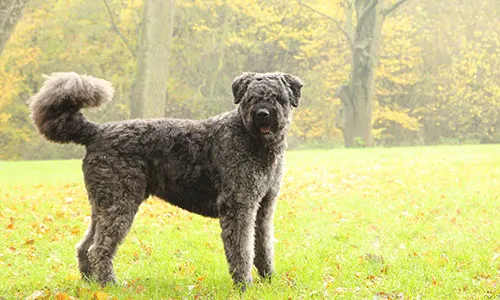 A shaggy Bouvier des Flandres with a strong, barrel-chested build, looking alert.
A shaggy Bouvier des Flandres with a strong, barrel-chested build, looking alert.
The Bouvier des Flandres is a burly, barrel-chested working dog known for its tousled, shaggy coat that sheds very little. Originating from Flanders, where they were used for herding and guarding, these dogs are intelligent, steady, and make excellent watchdogs. Their dense, double coat needs consistent brushing several times a week to prevent matting and regular trimming every 6-8 weeks. Despite their imposing appearance, Bouviers are known for their calm and loyal disposition, making them devoted family members. They require regular exercise and mental stimulation to prevent boredom and ensure they remain well-behaved, proving to be adaptable companions in homes that can meet their needs.
Giant Schnauzer
 A majestic Giant Schnauzer with its characteristic bold, whiskered face and black coat.
A majestic Giant Schnauzer with its characteristic bold, whiskered face and black coat.
The Giant Schnauzer is a powerful and intelligent breed, essentially a larger version of the Standard Schnauzer. Their wiry, dense coat is low-shedding, contributing to their reputation as a good choice for allergy sufferers. Grooming involves weekly brushing to prevent mats and preserve the texture of their coat, along with professional stripping or clipping every few months. These bold and valiant dogs possess great intelligence and unwavering loyalty, making them exceptional workers and companions. They thrive on having a “job” to do and require substantial exercise and consistent training. Given their protective nature, early socialization is key to developing them into well-adjusted family pets.
Kerry Blue Terrier
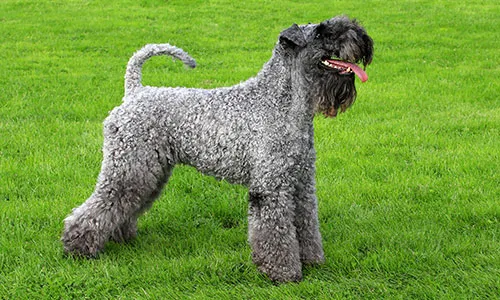 A Kerry Blue Terrier with a distinctive wavy, blue-gray coat and an inquisitive expression.
A Kerry Blue Terrier with a distinctive wavy, blue-gray coat and an inquisitive expression.
Among the larger AKC terriers, the Kerry Blue Terrier is famous for its show-stopping, soft, wavy blue coat that sheds minimally. Hailing from Ireland, where it was once a farm dog, the Kerry Blue is now a vigilant watchdog and an animated family companion. Their unique coat requires daily brushing to prevent matting and regular clipping every 6-8 weeks to maintain its appearance and texture. These intelligent and adaptable dogs are full of personality, known for their playful nature and strong will. They need consistent training and plenty of exercise to channel their terrier energy constructively, making them engaging and devoted pets for experienced owners.
Komondor
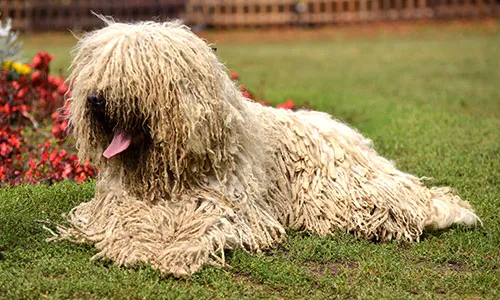 A unique Komondor dog covered in thick, white corded fur, resembling a mop.
A unique Komondor dog covered in thick, white corded fur, resembling a mop.
The Komondor is one of the world’s most recognizable breeds, a powerfully large Hungarian flock guardian known for its striking coat of profuse white cords that cover it from head to tail. This corded coat, when properly maintained, sheds very little. Grooming a Komondor is unique; their cords need to be separated regularly to prevent matting and ensure cleanliness, especially as they grow. This is not a breed for the faint of heart when it comes to grooming. Independent and highly protective, Komondors require a firm, experienced hand in training and early socialization. They are devoted to their families but can be wary of strangers, making them excellent watchdogs. For more information on various dog breeds and their unique characteristics, including their dog breed name and price in different regions, exploring dedicated resources can be very helpful.
Labradoodle
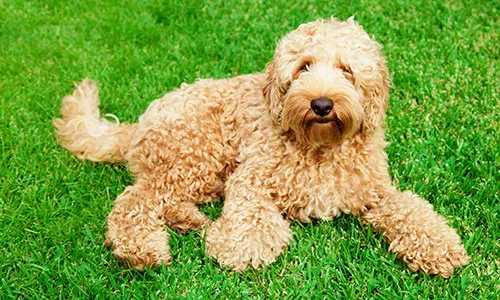 A friendly Labradoodle with a curly, cream-colored coat, looking attentively.
A friendly Labradoodle with a curly, cream-colored coat, looking attentively.
A delightful crossbreed between a Labrador Retriever and a Poodle (Standard, Miniature, or Toy), the Labradoodle has gained immense popularity, particularly for those with allergies. While not all Labradoodles are guaranteed low-shedding (it depends on which parent’s coat traits they inherit), many boast a curly, poodle-like coat that sheds minimally. Their grooming needs vary with coat type but generally require regular brushing to prevent tangles and professional grooming every 6-8 weeks for trims. Labradoodles are known for their friendly, intelligent, and energetic personalities, making them excellent family pets. They thrive on activity and companionship, eager to please, and generally good with children and other pets.
Standard Poodle
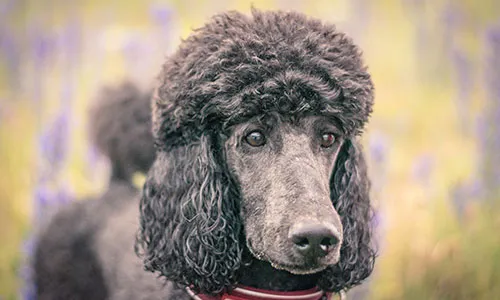 A regal Standard Poodle with its signature curly white coat, standing elegantly.
A regal Standard Poodle with its signature curly white coat, standing elegantly.
The Standard Poodle stands proudly among dogdom’s true aristocrats. Beneath their iconic curly, low-allergen coat is an elegant, athletic, and highly intelligent companion. Poodles are renowned for being low-shedding and are often recommended for people with allergies. However, their dense, continuously growing coat requires diligent grooming, including daily brushing to prevent mats and professional clipping every 4-6 weeks. Beyond their sophisticated appearance, Standard Poodles are highly trainable, eager to please, and excel in various dog sports. They are affectionate, playful, and make wonderful family pets, adapting well to different living situations as long as they receive adequate physical and mental stimulation.
Portuguese Water Dog
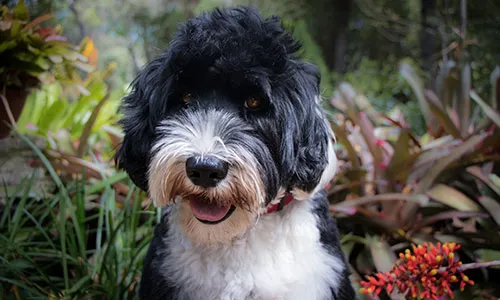 A robust Portuguese Water Dog with a curly black coat, looking ready for action.
A robust Portuguese Water Dog with a curly black coat, looking ready for action.
The Portuguese Water Dog is a robust, medium-sized dog bred to be an all-around fisherman’s helper. They are known for their intelligence, eagerness, and athletic build, specifically for water work. Their coat, consisting of tight, low-shedding curls, is a hallmark of the breed and comes in two types: wavy or curly. Regular grooming is essential to prevent matting, typically requiring weekly brushing and professional clipping every 6-8 weeks. Portuguese Water Dogs are lively, spirited, and very loyal companions. They thrive on activity and mental engagement, making them ideal for active families or individuals who can provide them with plenty of opportunities for exercise, especially swimming.
Irish Water Spaniel
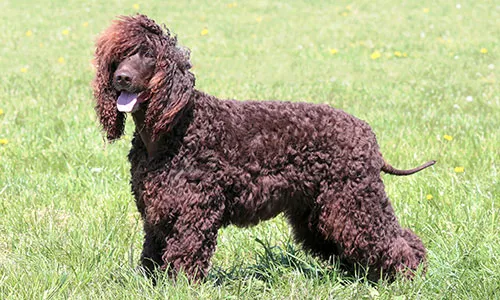 An Irish Water Spaniel with a distinctive topknot and crisp, brown curls, standing alert.
An Irish Water Spaniel with a distinctive topknot and crisp, brown curls, standing alert.
As the tallest of the AKC’s spaniels, the Irish Water Spaniel is instantly recognizable by its crisply curled, low-shedding coat and unique “rat tail.” These alert and inquisitive dogs are champion swimmers, bred for retrieving waterfowl. Their dense, curly coat requires regular brushing to prevent matting and occasional professional grooming. Irish Water Spaniels are hardworking and brave in the field, and playfully affectionate at home, making them versatile companions. They possess a keen intelligence and a joyful, sometimes mischievous, personality. Owners should be prepared to provide plenty of physical exercise and mental challenges to keep this energetic and charming breed happy and well-behaved.
Standard Schnauzer
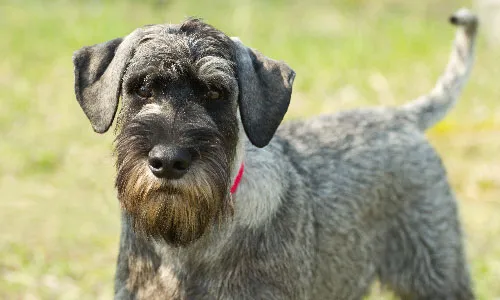 A bold Standard Schnauzer with a striking salt-and-pepper coat and classic beard.
A bold Standard Schnauzer with a striking salt-and-pepper coat and classic beard.
The Standard Schnauzer, the original of the three Schnauzer breeds, is a high-spirited farm dog from Germany with a bold, bewhiskered appearance. Their harsh, wiry double coat sheds minimally, making them another excellent choice for those seeking bigger dogs that don’t shed a lot. Grooming involves regular brushing to prevent mats and maintain coat health, along with stripping or clipping every few months. Known for their intelligence, reliability, and sometimes willful nature, Standard Schnauzers are devoted family members and vigilant watchdogs. They require consistent training, early socialization, and plenty of exercise to thrive, offering a blend of sporty good looks and an active, engaging personality.
Soft Coated Wheaten Terrier
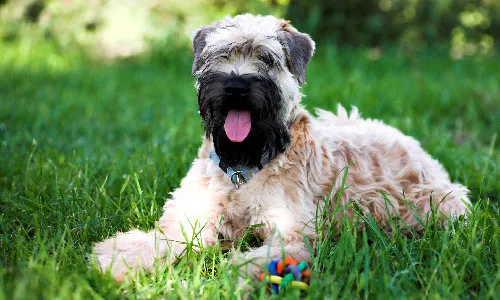 A cheerful Soft Coated Wheaten Terrier with a soft, wavy wheaten-colored coat.
A cheerful Soft Coated Wheaten Terrier with a soft, wavy wheaten-colored coat.
The Soft Coated Wheaten Terrier is an exuberant Irish farm dog, renowned for its silky, low-shedding, wheaten-colored coat. Happy, friendly, and deeply devoted, Wheatens possess enough terrier stubbornness to keep things interesting. Their unique coat, while low-shedding, requires diligent care to avoid matting, including daily brushing and professional grooming every 4-6 weeks for trims. Wheatens are known for their “Wheaten Greetin’,” a joyful jump-up welcome for their loved ones. They are active and playful dogs that thrive on companionship and require regular exercise and positive reinforcement training to be well-adjusted family members. Choosing the best pet dog for home often involves considering their grooming needs and how they fit into your daily routine.
Spanish Water Dog
 An active Spanish Water Dog with a coat of woolly, tight curls, looking energetic.
An active Spanish Water Dog with a coat of woolly, tight curls, looking energetic.
The inexhaustible Spanish Water Dog is a dual-purpose breed, historically used as both a herder and a waterfowl retriever. Their hallmark is a rustic coat of woolly curls that sheds minimally when properly maintained. The coat should not be brushed but rather left to form cords, which need to be separated manually. Regular trims are necessary to keep the coat at a manageable length. This lively charmer is a vigilant watchdog and a devoted family companion, known for its intelligence and eagerness to please. Spanish Water Dogs require significant physical and mental exercise, thriving in active homes where they can utilize their natural working instincts and boundless energy.
Conclusion
Choosing a bigger dog that doesn’t shed a lot offers the best of both worlds: the commanding presence and loving companionship of a larger breed without the constant clean-up associated with heavy shedding. From the elegant Afghan Hound to the energetic Spanish Water Dog, these breeds demonstrate that a low-shedding coat doesn’t compromise on size or personality. However, it’s crucial to remember that “low-shedding” does not mean “no maintenance.” These dogs require dedicated grooming, often including regular brushing, bathing, and professional trims, to keep their unique coats healthy and free from mats.
Before welcoming one of these magnificent dogs into your home, thorough research into their specific temperament, exercise needs, and grooming requirements is essential. Understanding the commitment involved ensures a happy and healthy life for your new companion and a harmonious household for everyone. Explore our other articles on all dog breed names and prices to find the perfect addition to your family.
References:
- American Kennel Club (AKC): https://www.akc.org/dog-breeds/
- PetMD: https://www.petmd.com/
- American Lung Association: https://www.lung.org/
- All About Pets Provo: https://www.allaboutpetsprovo.com/
